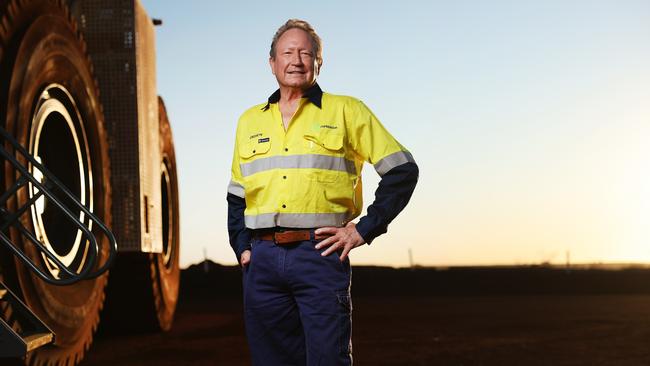
At the iron ore miner’s annual results presentation to analysts on Wednesday, even the most experienced observers had questions about the details of the plans of its energy arm, wondering when or if the company’s ambitious green energy projects around the world would make money.
While there was a lot of focus on the strength of the earnings from Fortescue’s iron ore operations in its full-year results, its green energy arm, Fortescue Energy, reported a loss before depreciation, interest, tax and amortisation of $US659m ($970m) for the year.
Fortunately, the iron ore business, which contributes almost 90 per cent of its $US18.2bn in revenues, is still so profitable that the company reported underlying earnings before interest, tax and depreciation of $US10.7bn – up by 7 per cent over the year.
On the face of it, it was a strong set of results, particularly given weakening global iron ore prices, with the company reporting its third-strongest earnings ever.
Shareholders, including Andrew Forrest and his wife Nicola, were rewarded with a 70 per cent dividend payout with total dividends of $1.97 a share – a payout of a cool $6.1bn.
But while the outlook for iron ore demand in China remains a key determinant of its future earnings in the short term, most of the questions in the analysts’ presentation were on the plans for the Fortescue Energy business.
The word “green” got mentioned a lot. Green hydrogen, green ammonia, green iron ….
The company now has two distinct arms, Fortescue Metals run by Dino Otranto, who oversees its profitable iron ore operations, and Fortescue Energy, run by Mark Hutchison, who oversees Fortescue’s array of green projects. Such is the status of Fortescue Energy these days that the two are described as “co-CEOs” reporting to Forrest as the globetrotting founder and executive chair.
After looking at a wide array of potential green projects round the world, and facing rising energy costs globally, FMG has had to focus its thinking this year, scaling back its green hydrogen ambitions and announcing in July that FMG would be cutting 700 jobs from the total business.
The Energy division is expecting to spend $US1.2bn during the year – $US700m on operations and $US500m on capital expenditure (a significant increase on the $US317m capex for the energy arm in the financial year just ended).
The division, which had its gestation period in several trips around the world by Forrest in his jet in the depths of Covid, has now settled on its first energy projects.
It recently turned the first sod on its green hydrogen project in the US, Arizona Hydrogen, which is expected to start construction this year with production set for 2026, and started work on a 50MW green hydrogen project in Gladstone in Queensland using FMG’s own electrolyser technology. Production of green hydrogen from the Gladstone plant is expected to begin in 2025, potentially getting to 22 tonnes of green hydrogen a day.
Next on the horizon, but not yet given the final go ahead by the FMG board, are a 300MW green ammonia project in Holmaneset, Norway, and a green hydrogen project in Pecem, Brazil. These are “progressing to feasibility stage”.
The company is expecting the Norwegian project to cost something just over $US1bn, with the Brazilian project potentially costing three times that – a total potential capital outlay of more than $USS4bn.
But Fortescue executives were at pains to point out that not all of that would be put on the FMG balance sheet, with the company expecting to get some money from the EU for the Norwegian project and other investors expected to come in to help finance both projects. Just how much FMG would need to spend on the projects and when they would make a profit was not clear.
Further down the track are potential projects in Morocco, Oman, Egypt and Jordan.
Energy chief Hutchison assured analysts that the company’s “financial discipline always comes first. We are only focused on those projects which are economically viable.” He said the green hydrogen market was “still developing”, with the cost of power needed to make green hydrogen projects in many countries economically viable too high.
“What we don’t do is give up,” he said. “When power costs are prohibitive, we will work to bring those costs down.
“Longer term, we totally believe that green hydrogen is what the world ultimately needs which is why we continue to maintain a significant portfolio of potential projects. There’s plenty to be excited about and we are focused on making business decisions that make sense, economically and commercially.”
Executives also argued that FMG’s green iron plans would also provide more revenue in China. Otranto said the company was “doubling down on green iron”. He now believed the opportunity for it in China was “much, much higher than expected” following a visit to the country.
Beijing, he said, had recently mandated that 10 per cent of all its coal-fired boiler feedstock would have to be ammonia.
This, he said, would translate into demand for 300,000 tonnes of ammonia a year which would need some 50 million tonnes of hydrogen to produce.
“The train has definitely left the station,” he declared.
Once content to sit back and watch iron ore shipments sail out of the Pilbara to China, FMG shareholders will need to get with the program when it comes to green technology – its potential and its green-sky economics.
Forrest is effectively asking his shareholders to back him in his green-energy vision, arguing that he has done it when it comes to iron ore and he will do it again when it comes to green-energy projects.
FMG shareholders need to sit back, buckle up their seat belts and strap in for the ride, as they count their dividends.


Investors in Andrew Forrest’s Fortescue Metals Group, who just want its healthy dividend stream to keep going, are having to live with a lot of “green sky”.